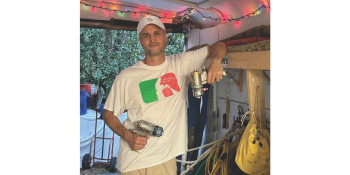Q&A Forums
over processing? Post New Topic | Post Reply
| Author | Comments |
|---|---|
|
steven argus
Posted: Nov 05, 2010 07:55 PM
|
over processing?
Hi Mason, Got some srinking OC foam. Spray 6-7 inches and it settles down to 4 inches. Yes, we have tried everything. We've been at this game for 5 years. 110 degrees to 140 degrees. 700 to 1500 psi. Guages equal. Our proportioner is only 1 week old. This foam did the same thing with our old gear too last week. We can spray brand x, y and z just fine. The only advice the "big name chemical" company can give us is "we're over processing". From my point of veiw they are telling me that I'm a moron. Is there any other reason why the foam may be srinking?
|
|
Gerry Wagoner
Posted: Nov 14, 2010 10:05 AM
|
Are you experiencing this shrinkage in both warm and cold application climates? |
|
mason
Posted: Nov 14, 2010 12:35 PM
|
Just about any foam will shrink under certain circumstances. And each foam can typically be sprayed without problems. The key is to find the reasons for the specific foam shrinking. The 3 most common reasons are 1. Foam sprayed too thick (creating excess exothermic heat, distorting the cell strucure) 2. Foam lifts sprayed too soon after each other (creating excess heat as well) 3. Foam not mixed well (due to spraygun configuration, temperature, or pressure. To find out how thick you can install the foam and how soon you can go back over it with another pass, take the temperature of the foam as it sets up. Spray a lifts of 1 inch, then 2 inches and next to that 3 inches all separate from each other. Take the temperature of the foam after a few minutes. Stick a meat thermometer into the center of the foam (that is where the foam temperature will be the hottest). If the foam temperature is 220 degrees F or hotter then that is beyond the thickness you should spray that particular foam. Anything hotter can cause the cells to lose their strength, become distorted and prone to shrinkage (also prone to odors). Then continue to take the temperature of the foam until the temperature begins to go down. That is time required before you can install another lift. Normally this would take 10 to 15 minutes for a 1-2 inch thick pass. But, it can vary considerably from one brand of foam to another. Also, make sure that you have the correct pressure, temperature and spraygun configuration for the foam. Each brand of foam can vary significantly from one to another in viscosity, so one might require different size nozzles, mixing chamber, module, PCD than another to mix the foam correctly. Some foams might require pre-mixing to ensure the B side is not separated. And check the temperature required to get the viscosity low enough to mix the foam well. If the foam is not mixed well, you can end up with too many open cells, low compressive strength, odors and poor dimensional stabilty. Call to discuss, 571-239-5221 |
|
steven argus
Posted: Nov 14, 2010 05:59 PM
|
Olger, substrate temps about 65* with kerosene heater. I believe this foam would work in the middle of summer. The manufacturer said there is a very small temp. window, 100 - 110 degrees. Too low for winter time spraying. we will be trying their new formula and they comped us for the foam and time we wasted. Mason, I will be purchasing a meat thermometer tomorrow, great advice, thank you. |
|
Daniel X
Posted: Nov 14, 2010 08:48 PM
|
I have to use a meat thermometer now too, the new formulation were supplied with uses an HCFC instead of CFC for a blowing agent and will exceed 200* in a hurry... I can put 2" of foam in one spot max before the temps get to high. |
|
Posted: Nov 15, 2010 06:01 AM
|
watch the kero heater,,lots of moisture being made,,,not as important with the oc though,, if you are seeing it sag back at the top of the rise,,at the time of appliation,,,,perfect!! drop your heat 5 degrees across the board and keep shooting,,,you want to get to point right between sag/no-sag... have seen "contaminated" resin in open cells before,,,this stuff shrank starting a few minutes after you shot it,,,it would roll up like biblical scrolls at the ends,,frequently with a half twist (degree of difficulty 4.2)down the entire bun,.. swapped it out and i like you returned it to its maker. it is a good thing you got service from your supplier. you must have been reasonable in your expectations. damned man they comped you for the time to? |
|
steven argus
Posted: Nov 15, 2010 07:50 AM
|
The kerosene heaters put less moisture into air than propane, right? We run the kero heaters long enough to get the substrate heat up to 50 degrees. Got my eye on a nice used indirect fired heater. Yes, we dropped the temp 5 degrees, waited 20 min, sprayed for a while, no change. Tried eveything - same results. We were comped 2 sets to cover time and material. Not enough in my book, but I'll take what I can get. Our distributor really went to bat for us. The manufacturer has an excellent product, I'm honestly not trying to badmouth them. I believe this to be an isolated problem and they made it right. Not sure if the resin was contaminated, old or just an old formula not designed for winter time, they eventually did help me out though. |
|
Daniel X
Posted: Nov 15, 2010 06:53 PM
|
Luckily most of my work is commercial so the heat is taken care of for me, I see a lot of these glycol exchangers running now... |
|
jimcoler
I have over 10 years of experience specifying and installing open and closed cell spray foam. I've sold my business but I'm still selling for the new owners and consulting on large and custom specific jobs. I've expanded my knowledge into t Posted: Nov 18, 2010 09:12 PM
|
Kero vs Propane - about the same moisture content. If you run a kerosene heater you can still be putting more moisture into the air on top of wet/green wood. This can be an issue with shrinkage and I've seen it numerous times. You are much better off with a warm but dry heat like electric heaters or blankets. Sometimes, even use a sealed combustion furnace temporarily piped into the space you're wanting to heat to keep it dry. Jim |
|
John Shockney
Posted: Nov 19, 2010 10:05 AM
|
Sometimes you get shrinkage with open cell due to lack of ISO in the mix with some manufactures. This is due to the thicker nature of the ISO compared to the open cell resin. Sometimes the answer is to increase the feed pump pressure for the ISO or increase the temp of the ISO at your machine. Also check the filter screens at your gun. I also have had to reduce the temps to cut back on shrinkage but that dose reduce yield. Hope this helps Airpro |
|
Gerry Wagoner
Posted: Nov 21, 2010 01:48 PM
|
We just purchased a 300k btu indirect fired diesel heater. Looking forward to trying it out. `oG |
|
steven argus
Posted: Nov 22, 2010 06:16 PM
|
Just knabbed an old furnace from an HVAC buddy. We're gonna look a little redneck, but thats not out off the ordinary. Maybe trailer mounted? |
|
mason
Posted: Nov 23, 2010 10:27 AM
|
I just re-read the original question and realized I made a large error. My recommendations were based on using a closed cell foam, not an open cell foam If you are having shrinkage problems with open cell foam, it is typically a mix problem, Either you need to agitate and/or mix the B side (ask your supplier for their instructions), or check out your gun configuration, pressure, heat, etc for proper balance of viscosities. Another thing to check on is unintentional moisuture contamination in the system. For example, air compressors can accumulate water in their tanks if the water traps and filters are not sufficient to stop condensation. This water can then get into your airlines and be sprayed onto the foam while you are installing it. This can cause an instantaneous shrinkage. I saw this happen a few years ago, while watching an open cell foam application. We opened up the air compressor tank and it was full of water. We drained the tank, added another water trap, opened a new drum of material and the shrinkage stopped. Cold substrate temperature can also affect the foam Sorry for the mix-up earlier. I read cc rather than oc. Mason |





























